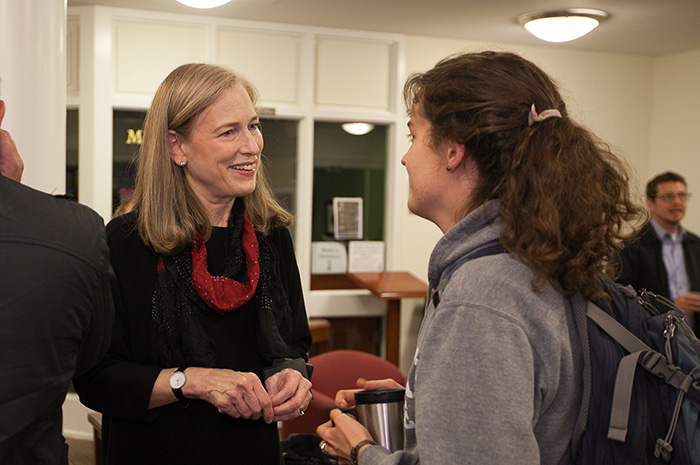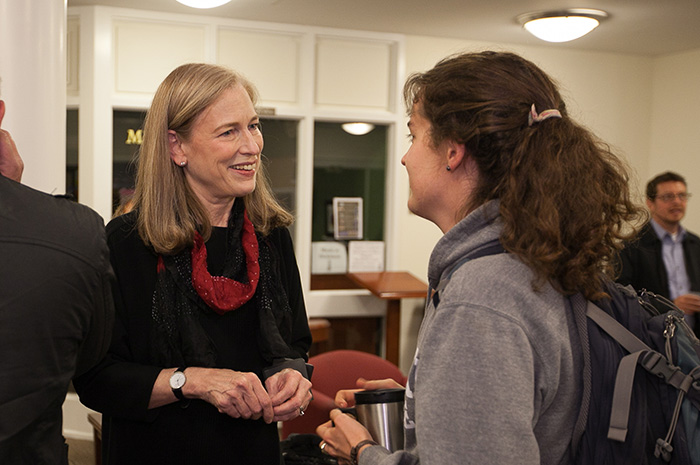A Strong Sense of Place

Sylvia Smith '73
For Sylvia Smith ’73, architecture is a call to better ways of living
by MaryAlice Bitts-Jackson, video by Joe O'Neill
Sylvia Smith ’73 didn’t know that she would become an architect when she first visited Dickinson back in the late 1960s, but she did know a great space when she saw it. “I stepped onto campus and I was captivated by the scale, the beauty of the buildings, the people and the energy,” she said, beaming at the memory. “There was a real sense of place, and I knew I wanted to be part of it.”
Today, Smith has cultivated many inviting and identity-infused spaces of her own, as a senior partner at FXFOWLE Architects, a major Manhattan-based architectural firm. Last week, she visited the campus for a public discussion about how she uses geometry, scale, texture, color and shape to teach, communicate and inspire. She also worked directly with students and attended a ceremony celebrating the formal completion of a project that wedded her passion for her alma mater with her love of environmentally and socially sustainable design.
Collaborative vision
A Dickinson College Metzger-Conway Fellow and fellow of the American Institute of Architects—the organization’s highest honor—Smith has served on the college’s board of trustees for 12 years. As chair of the board’s Committee on Facilities, she consulted with the team of architects and Dickinson administrators who led the Kline Center expansion project, offering her unique design perspective as both a Dickinsonian and an architect.
With its open, light-filled design, energy-efficient systems and indoor-outdoor social areas, the Kline expansion blurs the lines between the natural and the manmade, and its visual extension of Dickinson Walk—a pathway through the heart of the campus—creates a clear straight line that connects the Kline Center to the rest of the campus. “Our conversations with Sylvia dramatically changed this space we’re in—she pushed the geometry,” said lead architect John Reed of Cannon Design, speaking during the ribbon-cutting ceremony in the Kline extension’s lobby. “When I look around, I see that collaboration.”
The building also is skirted by a usable landscape that includes a basketball half-court, a stretching/exercise-class patio, a juice bar and an outdoor socializing area with moveable tables and chairs. “Students hang out in this area now, and it has changed the social dynamics on this part of the campus,” said Director of Athletics Les Poolman, tapping a core mission for the building project, and for Smith’s career.

Sylvia Smith '73's residency on campus included a public lecture, classroom visits, studio critiques and an exhibit of her architectural drawings.
The activist-architect
Like all good sustainable design, the Kline expansion is not just visually pleasing—its aesthetics communicate and support the values and culture of the people who inhabit it. In fact, Smith asserted, the beauty enhances the building’s function by influencing the ways in which its people interact with one another and with their environments. In this view, created spaces become works of social advocacy, designed to enhance lived experiences and spark positive change.
That fact lies at the heart of Smith’s mission and work. “To me, architecture has never been a job—it’s been a way of understanding and interacting with the world,” she explained. “Good architecture is more than complex problem-solving and pursuit of principles of sustainability. It captures intangibles. Art enters in.”
That message was clear to art & art-history majors Lucas Kang ’16, Elizabeth Wilford ’16 and Meghan Abercrombie ’15 and to Jenna Hess ’15, a double major in art & art history and psychology. All attended Smith’s public lecture and sought her advice during her classroom visits. And as senior studio-art majors, Hess and Abercrombie also invited Smith into their studio spaces so she could critique their work.
For Kang, who had considered an architecture career before arriving at Dickinson, Smith’s visit inspired a renewed interest in the field, while Hess, Wilford and Abercrombie were invigorated by the chance to talk with an accomplished alumna whose interests overlap with their own post-graduation plans.
Like Smith, Hess aims to use her art education for the public good—in her case, at the individual level, as an art therapist. Wilford is applying to a graduate architecture program in Copenhagen, while Abercrombie explores possibilities in the non-studio artistic realm.
“It was really helpful to have her visit my studio and talk to me directly about my work and my plans for the future, especially since I am looking to follow a similar path,” said Abercrombie. “As she said, if I leave myself open to opportunities, something great will come along to help get me to where I want to go.”
Learn more
- "An Architect’s View"
- Calendar of Arts
- The Liberal Arts at Dickinson
- Alumni in Action
- Department of Art & Art History
- Latest News
Published October 28, 2014